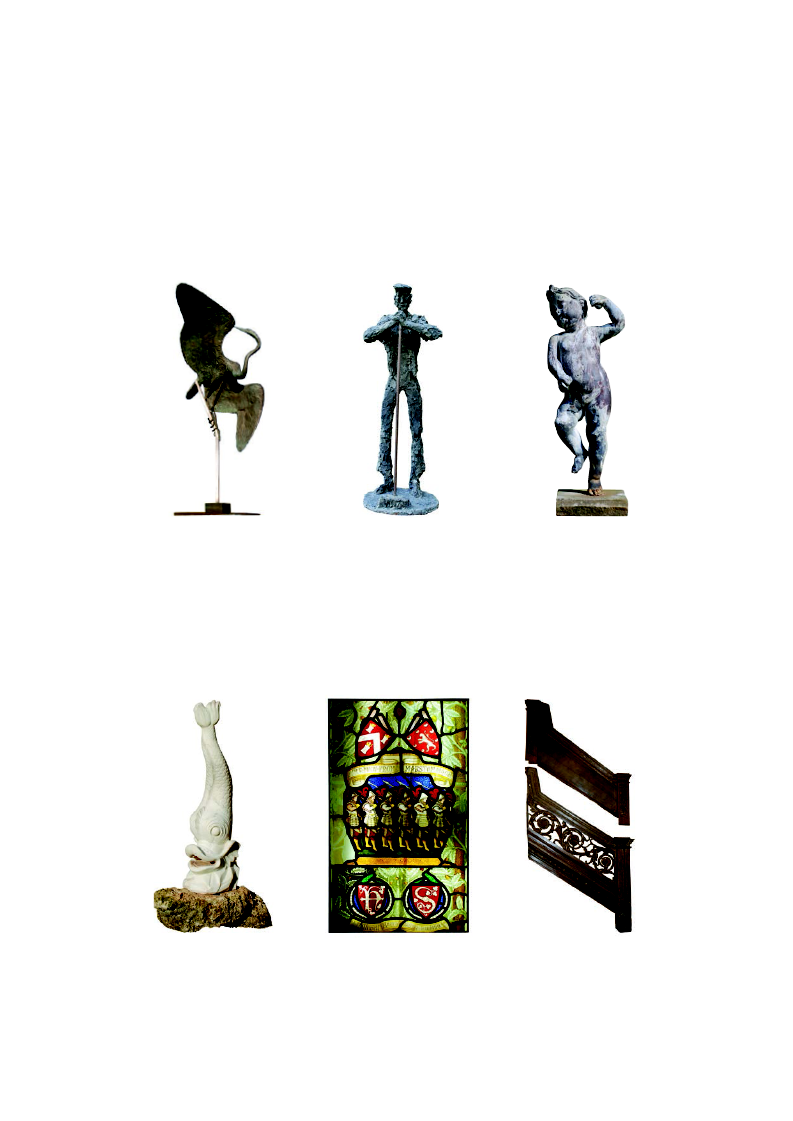
Architectural Heritage
Spring Catalogue of
PERIOD GARDEN STATUARY
ARCHITECTURAL ELEMENTS
& MODERN SCULPTURE
I am pleased to announce that our spring catalogue of Period Garden Statuary,
Architectural Elements and Modern Sculpture is now available.
Preening Bird
Street Sweeper
An early 18th Century
by David Wynne
by Peter Laszlo Peri
lead figure of a dancing
Cast in bronze with
(1899 – 1967)
girl with cymbals from the
an aluminium stem,
Modelled in coloured
workshops of
monogrammed and dated
cement (known as
John van Nost the Elder
1966, numbered 2 of 6
‘Pericrete’), circa 1955,
signed ‘Peri’
An early 19th century
The Pyke House Glass
The Crakemarsh Hall Staircase
carved marble dolphin
A series of mid-19th
A carved oak staircase
fountain, circa 1820,
century painted glass
in the manor of Edward
mounted on Tufa rock
panels, showing the family
Pearce, circa 1670
tree and history of Pyke
House since the Civil War
Period Garden Statuary
A recent discovery of an early 18th century lead figure of a dancing girl with cymbals
from the workshops of John van Nost the Elder (1686–1711–1713), previously thought to
be 1729. The disputed death date of John van Nost is an example of the grey areas that
surround early lead ornament. The question of authentication of early English lead
work is fraught with difficulty. This model of a dancing putto could relate to van Nost’s
Master, one Arnold Quellin (1653–1686), whose wife, on his passing, van Nost married,
and indeed this work notwithstanding the possible Low Countries connection to the
Larson family, could have indeed been modelled and cast by Andrew Carpenter (1677–
1737), he being principal assistant at van Nost’s workshops in London’s Haymarket.
It is then confusingly also possible that this work could be a later casting from an early
mould by ‘the man at Hyde Park Corner’ John Cheere (1709–1787) who took over van
Nost’s business and moulds upon van Nost’s death. All this said, it is most likely that
the stylistic similarities to the fighting putti at Melbourne House and the general
manner of the piece points firmly towards John van Nost the Elder.
The figure shows a naked, save the ‘classic’ later applied fig leaf, putti dancing with
cymbals, on tip-toe with the body in movement and her head to one side. The figure
sports a hairstyle not dissimilar to other known models by van Nost.
Also illustrated on this press release is an unusual early 19th century carved marble
dolphin spout, as an example of the stock in trade of fine examples of 18th, 19th and
early 20th century period garden ornament featured in the catalogue; this also includes
two 18th century Portland stone sundials, a life-size 19th century French terracotta
Bacchante along with urns, planters, tables, seats etc.
Architectural Elements
Following Architectural Heritage’s quest to find the most interesting and unusual
architectural elements, with provenance, we are pleased to show the recently conserved
late 17th century carved oak staircase, rescued from Crakemarsh Hall prior to its
demolition in the late 90s. Seen by Nikolaus Pevsner, Crakemarsh Hall was described
as ‘a compact two-storied stucco villa circa 1820. All very quiet and modest: and a
surprise to find that the house seems to have been built (or possibly rebuilt) around a
sumptuous 17th century staircase.’ The stair, now without runners and risers, comprises
of three extravagantly carved oak rising rails with a return gallery. The acanthus scroll,
floral motifs and intertwining snakes are carved in the manor of Edward Pearce (circa
1630–1698) and could relate to a series of stairs carved around 1670 of which Tredegar
House retains a fine example.
Shown again is the extraordinary early 17th century oak staircase, which was previously
thought to come from Wynnstay Hall. We are awaiting confirmation from dendro-
chronology, due in early next week, to finally confirm that the stair came from Llwyn
Ynn Hall, near Ruthin. Now demolished, this historic property was where the Welsh
Bible was translated - with a firm date and known provenance this staircase can now be
considered of national importance.
Other interesting elements to be shown are a series of stained glass panels removed
from Pyke House in Lancashire prior to its demolition in the 1960s. Describing the
history of the house and the families which lived there from the Civil War until the 19th
century, these stained glass panels have been untouched in storage for over 50 years.
Modern Sculpture
Shown here are two sculptures from the 1960s. Cast in bronze with an aluminium
stem, monogrammed and dated 1966, numbered 2 of 6, ‘Preening Bird’ relates to a
series of bird sculptures by David Wynne exhibited at Arthur Tooth & Sons, Bruton
Street, London W1, in March 1966. Preening Bird is listed and illustrated in the original
catalogue and was interestingly priced at £420.
‘Street Sweeper’ by Peter Laszlo Peri (1899–1967), modelled in coloured cement
(known as ‘Pericrete’), circa 1955, signed ‘Peri’. Peri himself described how, when
he as making sculpture of a social type, such as a street sweeper, he would "..show
him not as a pompous heroic figure, but as part of our surroundings. I choose one of
his characteristic resting poses, I have drawn my neighbour’s attention to another
neighbour whom he passed a thousand times on the street, but to whom he never gave
a second thought." Extracted from Sculpture in 20th Century Britain - A guide to
sculptors in the Leeds collection. Peri exhibited widely and his works are held in the
Tate, British Museum and Leeds City Art Galleries among other galleries.
Please do not hesitate to contact me if you require additional information or high
resolution images.
Thank you for your interest.
Kind regards
Alex
Architectural Heritage
email: puddy@architectural-heritage.co.uk
phone: +44 (0)1386 584414
web: http://www.architectural-heritage.co.uk